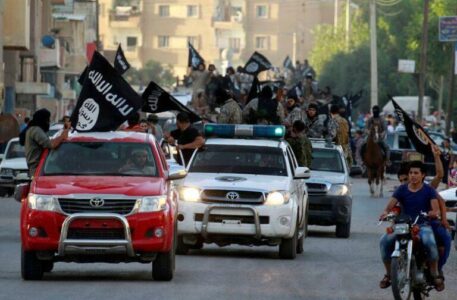
Islamic State revives terror attacks amid futile counter campaigns in Syria
After the beginning of the Syrian revolution in 2011, the Islamic State (IS) group expanded its activity to include Syria to “support the Syrian people,” according to IS’ claims presented in a propaganda documentary entitled “The End and the Beginning,” released in January 2021.
However, IS’ presence declined and its influence shrunk in Syria following the intervention of the US-led International Coalition Forces (ICF) in 2015, which launched extensive battles against IS in Syria and Iraq.
As a result, the military group, which emerged from the remnants of the al-Qaeda in Iraq, moved from a clear and open fighting strategy to conducting operations in scattered geographical pockets, with the Syrian Desert as the main stage for its operations and the knot that kept unloosened despite years-long military action and security campaigns by different armed parties in Syria.
On 19 January, IS carried out a massive operation to free its arrested leaders and members from Ghweran prison in al-Hasakah, which is under the full control of the Kurdish People’s Protection Units (YPG) and the ICF’s protection.
In this in-depth article, Enab Baladi discusses with experts and researchers the recent increase in IS’ systematic attacks, as opposed to failed military efforts to curb its activities and limit its risks. Enab Baladi also highlights the importance of the Syrian Desert to IS and the current military action undertaken to eliminate the Islamic State.
Although IS does not specify the locations of its 2,748 attacks worldwide, which were mostly carried out with explosive devices, booby-trapped vehicles, and mines, Syria ranked third in the number of IS attacks with 368 targetings that resulted in 736 deaths, according to statistics published by the Telegram channel of Amaq Agency, IS-run news outlet, on 9 January.
The statistics included IS attacks in different spheres of influence across Syrian geography without specifying their geographical distribution.
After IS’ control diminished in Syria, the militant group adopted guerrilla tactics. It carried out hit-and-run operations, benefiting from the geography and terrains of the Syrian Desert, where IS sleeper cells would target regime forces’ convoys and the Syrian Democratic Forces (SDF).
IS fighters and sleeper cells’ movements in the Syrian Desert are undetected, as militants appear on scene only to carry out attacks and disappear again in the desert.
The Syrian Desert covers the areas from the eastern countryside of Hama and Homs governorates to the Iraqi borders and from the countryside of Deir Ezzor and Raqqa in northern Syria to the Syrian-Jordanian borders.
It covers a total area of over 75,000 square kilometers out of Syria’s land area of about 185,000 square kilometers.
The early weeks of 2022 witnessed several operations by IS in the Syrian Desert area; the latest was on 6 January and led to the killing of three regime’s elements and the wounding of four others in two separate attacks in the Raqqa countryside.
IS did not claim responsibility for the operation against the regime forces, but many local news networks indicated back then that IS cells carried out the targeting.
Three days earlier, IS attacked a group of regime soldiers in the Homs Desert in eastern Syria and killed five of them.
The state-run Syrian Arab News Agency (SANA) cited a military source it did not name that a military bus was targeted by an IS’ rocket attack, 50 kilometers to the east of the T3 oil pump station, noting that the attack killed five military personnel and injured 20 others to various degrees.
Homs and Deir Ezzor governorates are among the areas to witness the most centered presence for Iran-affiliated militias in Syria, a study by the Jusoor Center for Studies mentioned, noting that Deir Ezzor alone contains 64 military sites and 512 posts, controlled mainly by Iran.
In early 2021, IS increased its attacks in Deir Ezzor governorate, starting with the targeting of Hussein Sheikh al-Jamil, one of the dignitaries of the al-Bakir clan in the al-Izba area to the north of Deir Ezzor.
Al-Bakir is one of the clans of the al-Akidat tribe, which had some of its dignitaries targeted in early 2021; the latest was Sheikh Atlyush al-Shitat al-Lafi, who was killed on 12 January 2021.
Commander in SDF’s First Regiment, Suleiman al-Abboud al-Latto (aka the Scorpion), was killed in the countryside of Deir Ezzor in mid-June 2021.
In a statement published by IS-affiliated Amaq Agency in May 2021, IS claimed responsibility for the targeting and shooting of a member of the Autonomous Administration of North and East Syria (AANES)’s religious institution in the village of al-Geneina, leading to his killing by gunshots.
Moreover, ten workers of al-Kharata oil field in the southwestern countryside of Deir Ezzor were killed on 2 December 2021, according to SANA.
SANA reported a “terrorist attack” against a bus carrying workers returning from the al-Kharata oil field, leading to the death of ten of them and the injury of another worker.
On 3 December 2021, two elements of the regime forces were killed by an IS attack on the regime’s military sites in the desert of Deir Ezzor.
The National Defense Forces (NDF), a pro-regime militia in Deir Ezzor, confirmed on its Facebook account on 2 December 2021 the killing of two of its elements by an IS attack in the desert of al-Masarab in the western countryside of Deir Ezzor.
On 12 December 2021, IS took responsibility for the killing of SDF leader Adham Dibish al-Abes (aka Abu Abdullah al-Jarthi) and one of his companions in Thiban town, east of Deir Ezzor.
On the same day, IS acknowledged the abduction and killing of an SDF element in Hajin town in the eastern countryside of Deir Ezzor. However, the identity of this person remains unknown till the writing time of this article.
Source: Enab Baladi





